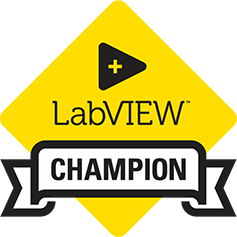- Subscribe to RSS Feed
- Mark Topic as New
- Mark Topic as Read
- Float this Topic for Current User
- Bookmark
- Subscribe
- Mute
- Printer Friendly Page
Creating a nice interface
07-06-2017 12:29 PM
- Mark as New
- Bookmark
- Subscribe
- Mute
- Subscribe to RSS Feed
- Permalink
- Report to a Moderator
how can i create a nice interface with proper alignment and spacing in labview ..like this
07-06-2017 12:54 PM
- Mark as New
- Bookmark
- Subscribe
- Mute
- Subscribe to RSS Feed
- Permalink
- Report to a Moderator
Time and effort... and also, don't be colorblind like I am. 😉
(Mid-Level minion.)
My support system ensures that I don't look totally incompetent.
Proud to say that I've progressed beyond knowing just enough to be dangerous. I now know enough to know that I have no clue about anything at all.
Humble author of the CLAD Nugget.
07-06-2017 01:01 PM
- Mark as New
- Bookmark
- Subscribe
- Mute
- Subscribe to RSS Feed
- Permalink
- Report to a Moderator
Could you explain more about the problems you're running into in creating an interface like that?
It looks like most of those controls are system. You just place them down where you want them to be on the front panel. Use the toolbar to neatly line them up.
If you are asking about how to make it resizeable, that is trickier. Usually what I do is plan my UI carefully so there is a part of it that doesn't need to expand (like buttons), and then part of it that can easily expand as much as needed (like a graph) and then put them in separate panes and configure it so just the easily expanded part grows when the window is resized.
07-06-2017 01:18 PM - edited 07-06-2017 01:19 PM
- Mark as New
- Bookmark
- Subscribe
- Mute
- Subscribe to RSS Feed
- Permalink
- Report to a Moderator
It is possible. Here is something I knocked up in 10 minutes. I used a free UI toolkit from DMC (https://www.dmcinfo.com/services/test-and-measurement-automation/labview-programming/labview-ui-suit...).
There are plenty of toolkits free and paid on VI package manager. Flat Controls by JDP Science and the one from JKI are free and quite useful.
P.S: I don't have any association with any of the companies above.
07-06-2017 01:58 PM
- Mark as New
- Bookmark
- Subscribe
- Mute
- Subscribe to RSS Feed
- Permalink
- Report to a Moderator
the simple way is to add you components,
use the align functions as HopeH showed,
and enable the gridsnapping (i don't know what it is called)
en-/disable with CTRL+#
more involved is using splitters and tabs,
have a look at the containers palette,
and search for the terms in help/forum/google.
If Tetris has taught me anything, it's errors pile up and accomplishments disappear.
07-06-2017 04:12 PM
- Mark as New
- Bookmark
- Subscribe
- Mute
- Subscribe to RSS Feed
- Permalink
- Report to a Moderator
@billko wrote:
Time and effort... and also, don't be colorblind like I am. 😉
What can I say? The first time I tried to put together an interface with custom colors, someone physically cringed. It was then that I realized that I shouldn't be designing interfaces without help. 😉
(Mid-Level minion.)
My support system ensures that I don't look totally incompetent.
Proud to say that I've progressed beyond knowing just enough to be dangerous. I now know enough to know that I have no clue about anything at all.
Humble author of the CLAD Nugget.
07-07-2017
12:42 AM
- last edited on
02-25-2025
01:32 PM
by
![]() Content Cleaner
Content Cleaner
- Mark as New
- Bookmark
- Subscribe
- Mute
- Subscribe to RSS Feed
- Permalink
- Report to a Moderator
As a general guide, I always try to make simple and minimalistic GUI. Often, I use the System palette for the Front Panel controls/objects. This gives you a "usual" familiar looking interface similar to other applications in Windows. As an extra to the built-in System palette, I also install the following add-on: https://www.ni.com/en/support/downloads/tools-network/download.operating-system-ui-controls-toolkit....
Edit:
other thing I often overlooked in the past, that you should NOT show ALL input (control) options to the user at once. The GUI looks terrible if you have too many elements. There are several tricks how you can minimise the number of controls/indicators in your GUI. TABs can be OK, but might introduce big problems if overused. More pro solution using subPanels, but they require more programming. You can also consider using pop-up dialog windows, to give the user access to controls which are not frequently needed to be interacted, or indicators to see by the user.
Other useful thing is using custom Runtime Shortcut menus (https://knowledge.ni.com/KnowledgeArticleDetails?id=kA03q000000x3TOCAY&l=en-US ), either for the Top level VI's front panel, or for individual controls/indicators.
One example I often use: I have two indicators, one shows the actual Flow Rate of a flow controller. The other indicator shows the actual Set Point. I create a custom shortcut menu for the Setpoint indicator, so the user can change the setpoint via right mouse click, bringing up a menu, then depending on the choice, opening a dialog window...

